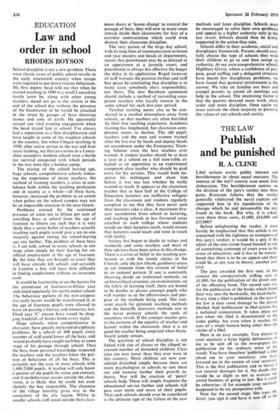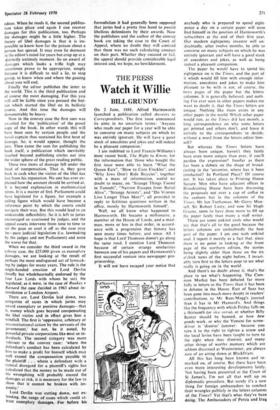THE LAW
Publish and be punished
R. A. CLINE
Libel actions excite public interest and bewilderment in about equal measure. The interest of the PQ17 convoy case needs little elaboration. The bewilderment centres on the division of the jury's verdict into three parts. Everyone follows that the verdict generally vindicated the naval captain and supported him in his repudiation of the charges which he and presumably the jury found in the book. But why, it is asked, were there three sums, £1,000, £14,000 and £25,000?
Before enlightening the reader, it must hastily be emphasised that this article is not concerned with the rightness or wrongness of this jury's verdict; it would be a pity if the editor of the SPECTATOR found himself at risk of'committing contempt of court even in the cause of education; and it has to be remem- bered that there is to be an appeal and there could be, at any rate in theory, another jury trial.
The jury awarded the first sum, in this context the comparatively trifling sum of £1,000, for the publication of the proof copy of the offending book. The second sum was for the publication of the books which found their way into the bookstalls, the hard-backs. Every time a libel is published, in the eyes of the law it does some damage to the person libelled. And 'publication' in libel actions has a technical connotation. It takes place not just when the libel is disseminated to the wider public, but even when it reaches the eyes of a single human being other than the victim of a libel.
Here is an easy example. You dictate to your secretary a letter highly defamatory of me to be sent off to the newspapers for publication (in the ordinary sense of the word). You have therefore 'published' a libel about me to your secretary; you have lowered me in the esteem of your secretary. This is the first publication and in theory I can recover damages for it. No doubt they would be so slight as not to warrant the awful business of going to law. But it could be otherwise—if for example your secretary happened to be my prospective wife. Now for the second stage. She types the letter, you sign it and have it sent off to the
editor. When he reads it, the second publica- tion takes place and again I can recover damages for this publication, too. Perhaps the damages might be a little higher. The theory of libel damages is that it is im- possible to know how far the poison about a person has spread. It may even lie dormant in the editor's mind for years but crop up at a distinctly untimely moment. So an award of damages which looks a trifle high may sometimes prove to be appropriate, simply because it is difficult to nail a lie, to stop gossip, to know when and where the gassing about you will end.
Finally the editor publishes the letter to the world. This is the third publication and of course the most damaging. For this you will still be liable since you pressed the but- ton which started the libel on its ballistic course. And this time the damages will demonstrably be heavy.
Now in the convoy case the first sum was awarded for the `publication' of the proof copy of the book. In other words thii will have been seen by certain people and the naval captain thus sustained_his first bout of damage. So, it would appear, thought the jury. Then came the sum for publishing the book itself, a publication which inevitably reached beyond publishing circles out into the wider sphere of the great reading public.
These two items of damage fell under the head of compensation. That is, they gave back in cash what the victim of the libel has lost from his reputation. No one has ever ex- plained how the amount should be arrived at. It is beyond explanation in mathematical terms. It is a matter of feel. Parliament could have legislated for a figure, for example a ceiling figure which would have become a reference point by which the courts could navigate their way. But this would lead to an undesirable inflexibility. So it is left to juries encouraged or cautioned by judges, and the appeal courts intervene from time to time to set the pace or cool it off as the case may be—pure judicial legislation (i.e. lawmaking by the judges and not Parliament) and none the worse for that.
When we consider the third award in the convoy case, the £25,000 given as exemplary damages, we are looking at the result of perhaps the most undisguised act of lawmak- ing by judges for many years. The rule is the single-handed creation of Lord Devlin (briefly but wholeheartedly endorsed by the four Law Lords with whom he sat). He legislated, as it were, in the case of Rookes v Barnard the case decided in 1963 about in- timidation at London Airport.
There are, Lord Devlin laid down, two categories of cases in which juries may award exemplary or punitive damages--that is, money which goes beyond compensating the libel victim and in effect gives him a windfall. The first is 'oppressive, arbitrary or unconstitutional'action by the servants of the government,' but not, be it noted, by powerful private corporations like BOAC or in- dividuals. The second category was more relevant to the convoy case: `where the defendant's conduct has been calculated by him to make a profit for himself which may well exceed the compensation payable to
the plaintiff . . . where a defendant with a cynical disregard for a plaintiff's rights has calculated that the money to be made out of his wrongdoing will probably exceed the damages at risk, it is necessary for the law to show that it cannot be broken with im- punity; Lord Devlin was cutting down, not ex- tending, the range of cases which could at- tract exemplary damages. For before his
formulation it had generally • been supposed that juries had a pretty free hand to punish libellous defendants by their awards. Now the publishers and the author of the convoy book are taking the case to the Court of Appeal, where no doubt they will contend that there was no such calculating conduct on their part. Whether they succeed or fail, the appeal should provide considerable legal interest and, we hope, no bewilderment.



































 Previous page
Previous page